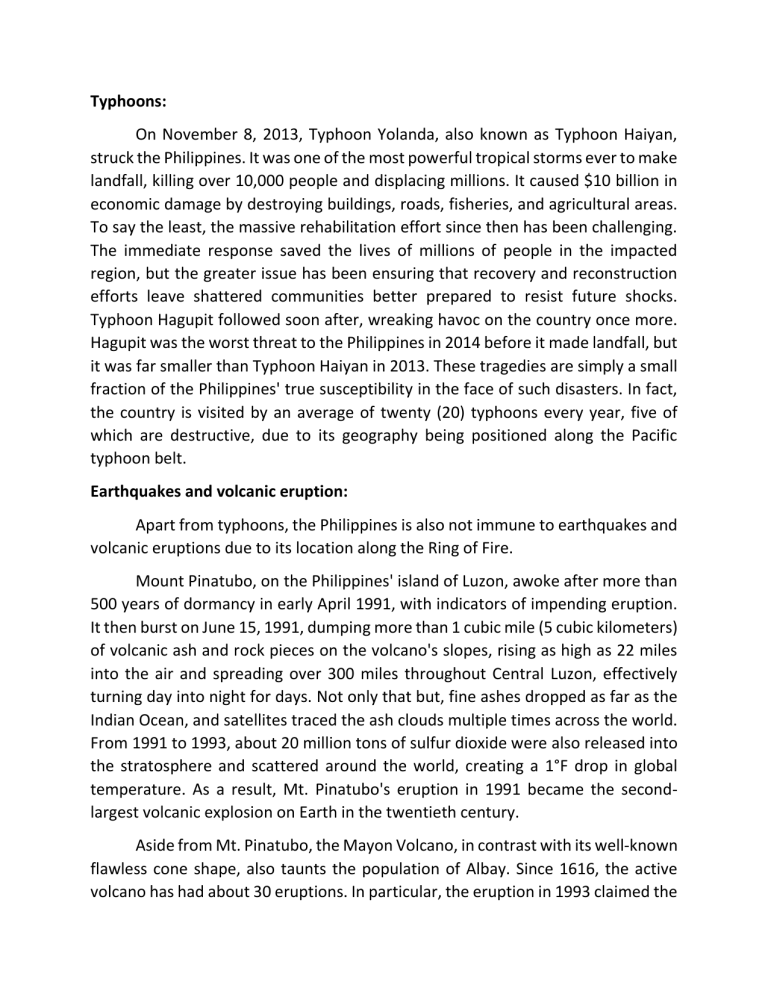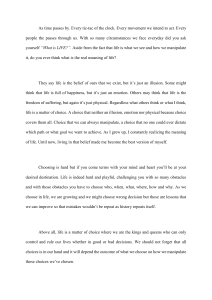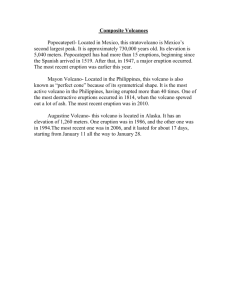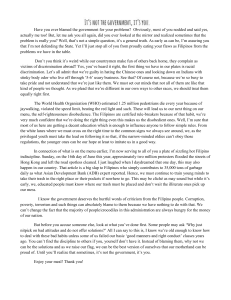
Typhoons: On November 8, 2013, Typhoon Yolanda, also known as Typhoon Haiyan, struck the Philippines. It was one of the most powerful tropical storms ever to make landfall, killing over 10,000 people and displacing millions. It caused $10 billion in economic damage by destroying buildings, roads, fisheries, and agricultural areas. To say the least, the massive rehabilitation effort since then has been challenging. The immediate response saved the lives of millions of people in the impacted region, but the greater issue has been ensuring that recovery and reconstruction efforts leave shattered communities better prepared to resist future shocks. Typhoon Hagupit followed soon after, wreaking havoc on the country once more. Hagupit was the worst threat to the Philippines in 2014 before it made landfall, but it was far smaller than Typhoon Haiyan in 2013. These tragedies are simply a small fraction of the Philippines' true susceptibility in the face of such disasters. In fact, the country is visited by an average of twenty (20) typhoons every year, five of which are destructive, due to its geography being positioned along the Pacific typhoon belt. Earthquakes and volcanic eruption: Apart from typhoons, the Philippines is also not immune to earthquakes and volcanic eruptions due to its location along the Ring of Fire. Mount Pinatubo, on the Philippines' island of Luzon, awoke after more than 500 years of dormancy in early April 1991, with indicators of impending eruption. It then burst on June 15, 1991, dumping more than 1 cubic mile (5 cubic kilometers) of volcanic ash and rock pieces on the volcano's slopes, rising as high as 22 miles into the air and spreading over 300 miles throughout Central Luzon, effectively turning day into night for days. Not only that but, fine ashes dropped as far as the Indian Ocean, and satellites traced the ash clouds multiple times across the world. From 1991 to 1993, about 20 million tons of sulfur dioxide were also released into the stratosphere and scattered around the world, creating a 1°F drop in global temperature. As a result, Mt. Pinatubo's eruption in 1991 became the secondlargest volcanic explosion on Earth in the twentieth century. Aside from Mt. Pinatubo, the Mayon Volcano, in contrast with its well-known flawless cone shape, also taunts the population of Albay. Since 1616, the active volcano has had about 30 eruptions. In particular, the eruption in 1993 claimed the lives of 79 people, and the five succeeding ones forced tens of thousands of residents from nearby villages to flee. On its most recent eruption, on the 14th of January 2018, the volcano saw two ava collapse events, resulting in rockfall and small-volume pyroclastic density currents. Ash clouds were also produced with ashfalls reported in 29 villages (barangays) in the municipalities of Camalig and Guinobatan in the southwest of the volcano. Lava flow, further rockfall episodes, and small pyroclastic flows were also seen on the 16th of January. Due to the potential of rockfalls, landslides, and abrupt explosions or dome collapse that may generate dangerous volcanic flows, PHILVOLCS advised that the 6-km permanent danger zone and a 7-km extended danger zone be enforced. Precautionary evacuations have been carried out in 25 villages (barangays) in three municipalities and two cities as a result of the increased alert level. A total of 5,318 households (21,823 persons) have been displaced as of 15 January, with 4,134 families (16,877) residing in 18 evacuation facilities. Filipinos’ Showcasing Resiliency during their most difficult times: In the event of any of the aforementioned obstacles or disasters, the Philippines proved to be one of the most resilient nations, surviving for years on end amid famine, sickness, and inadequate crisis management. Despite the country's circumstances, Filipinos maintain a positive attitude in their daily lives. They'd learnt how to properly pack their burdens so that they could carry them more easily. They have adapted to their circumstances since they have been confronted with them virtually their entire lives. They have always found a way to endure or recover from adversity, even in the direst of circumstances. Every time a typhoon hit the country, Filipinos saw it as an opportunity to replace or improve unjust or ineffective humanitarian responses in order to be better prepared in the future. Since they are aware of the country's vulnerabilities, they ensure that an emergency survival kit is constantly available at their houses, or that they have enough food and other supplies to last at least a month before the storm hits. People ascend to their roofs in locations where water is predicted to accumulate soon and send out SOS messages via instant messaging or Facebook posts. Because of the sudden torrent of rescue reports, Filipinos were eager to act after the landfall, notwithstanding their restricted mobility and delayed disaster response. Survivors begin to feel the weight of their disturbed lives on their shoulders at this moment, yet with psychological traumas, many would still fight for their lives. The community has also developed ways to integrate and assist one another in order to enhance their standard of living during these times. Filipinos really have a strong sense of resilience. They have the ability to perceive life not through colored lenses, but rather, to see that setbacks occur, and that life is full of trials and misery. They still have unfavorable emotions after a misfortune, but their mental approach allows them to work through them and recover. People with resilience have the ability to confront issues head on, overcome hardship, and move on with their life. Filipinos then see themselves as fighters rather than victims in this situation. Addressing it with the concept of Toxic Positivity: Regardless of the virtues of resilience, the narrative we have about it needs to be rectified. One can't help but be impressed by how resilient Filipino survivors are in the face of challenges but would otherwise be too much for others, especially those who are directly affected. As a result, we must be mindful that our stance toward it should not be romantic or amorous. Instead, Filipinos should also realize that they cannot rely just on themselves and that nothing can be addressed simply by being optimistic. We should continue to learn how to speak up for what we need and push for more from the government, because it is, after all, their duty in society. With this, we should not equate resiliency with toxic positivity and treat the former as if it were a moral problem when, in fact, it is a value to be proud of since it makes us stronger. The latter refers to the denial of negative emotions' existence and the belief that they should not be felt, therefore they are very different. Furthermore, Filipinos are also human beings who can experience both pleasant and negative emotions that are both transient. It's only a matter of keeping the proper perspective of it. Let's think of resilience as a balance scale where negative events tip the scale toward bad outcomes, and positive experiences tip the scale toward favorable outcomes, in order to develop it without toxic positivity. First, we may realistically assess undesirable incidents without focusing on blaming or worrying over what we can't alter. We should reframe our thoughts to look for tiny methods to approach the problem and make changes that will help, rather than perceiving adversity as hopeless. Talking about your problems won't make them go away but discussing them with a friend or loved one might help you feel like you've got someone on your side, which can help you build strength. Communicating with others can also help you gain insight or generate fresh ideas that can help you better manage the issues you're facing. Finally, we can practice stress and emotional management, as we can easily become overwhelmed by things that feel out of our control during a crisis. Rather than wishing you could go back in time or change things, try concentrating on the things you can directly influence.







